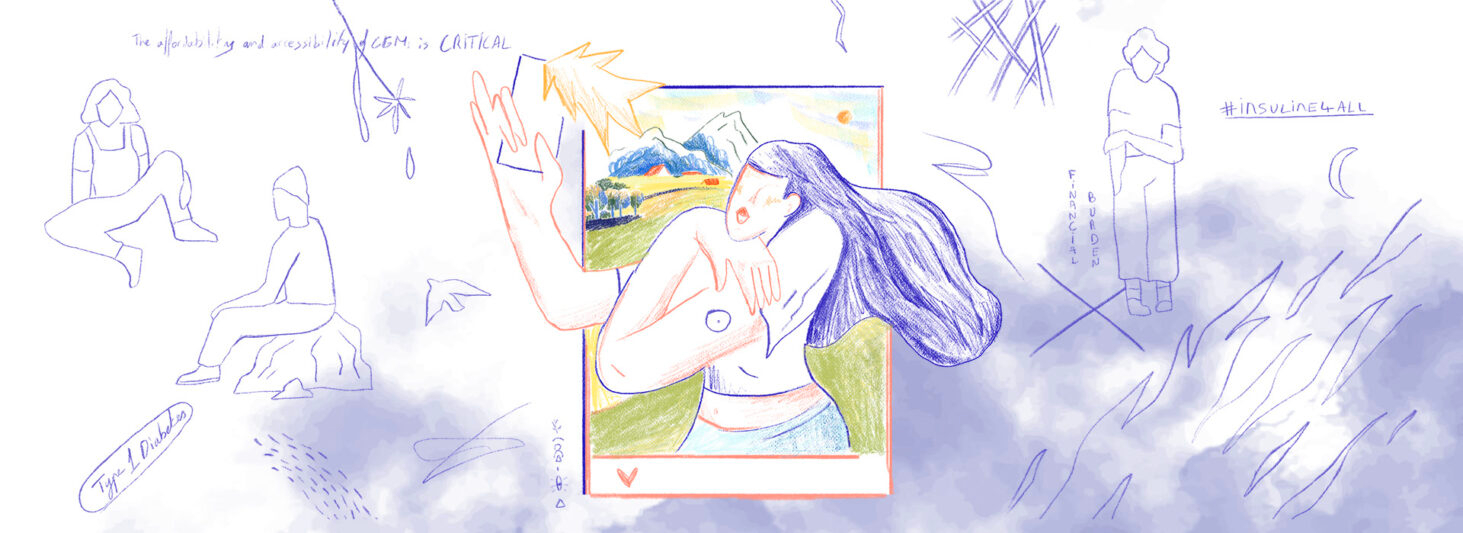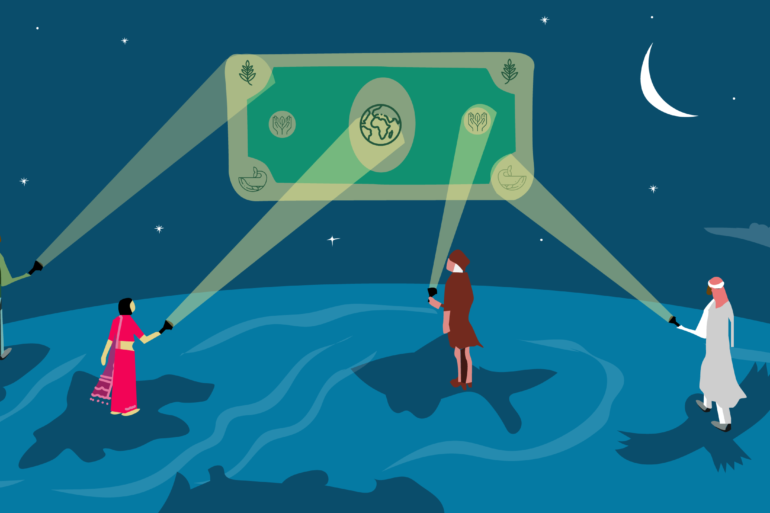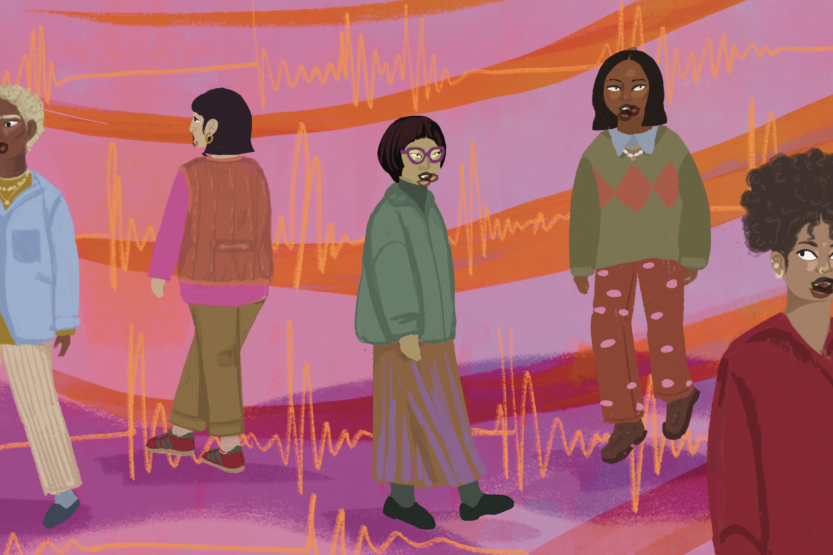I came across ZOE around eight months ago when my social media feed was flooded with videos of people painlessly (so it seemed) applying a small white disc with a needle to their arms, branded with a bright yellow patch. It was a bizarre concept to me – why was blood glucose monitoring becoming so normalised?
According to its website, ZOE is an app delivered nutrition programme, based on advice around monitoring blood sugar, blood fat and gut health, which includes the provision of a Constant Glucose Monitor (CGM) for users to track their blood glucose levels for two weeks while undergoing challenges to monitor their body’s response to ZOE-branded cookies.
Fast forward to October 2023 when I was diagnosed with Type 1 diabetes: a chronic condition where the pancreas produces little or no insulin, requiring lifelong management through monitoring and insulin injections. By nature of living in the UK and the incredible campaigning work by charities who have advocated for CGMs to be free of charge, I was automatically offered one on prescription. After two months of finger prick blood tests, I transferred to wearing the same CGM device (a Freestyle Libre 2) that I’d seen all over my feeds, just without the bright yellow ZOE sticker.
Self-monitoring of blood glucose, which a CGM provides, is an essential component of managing Type 1 diabetes and insulin-treated Type 2. Monitoring helps to accurately determine insulin doses and therefore minimise long-term health complications, which can include eye damage and neuropathy. While CGMs are a very advanced monitoring technology, finger prick tests are the more standard method (and still encouraged for CGM users occasionally to ensure accurate measurements).
Adverts for ZOE continued to appear in my feed since my diagnosis, particularly videos featuring non-diabetic influencers proudly applying and speaking about how their CGM is helping them manage a range of things like their sleep, fullness and energy levels. ZOE is framed by its influencers as a technology aiding their of their overall health; of course with no reference to its price or the socio-economic barriers to living a ‘healthy’ lifestyle.
A dangerous trend
At the individual level, the convergence of wearable technology with a tracking device designed specifically for Type 1 diabetics to closely monitor their sugar levels raises concerns about fostering an unhealthy relationship with food among non-diabetic users. As someone who is also recovering from an eating disorder, I’m particularly anxious that the proliferation of CGMs will lead to non-diabetic users developing restrictive behaviours; I’ve personally found constantly tracking my blood sugar in response to food massively triggering.
This is reflected in the statistics: according to Diabetes UK, up to 30% of people with Type 1 diabetes have an eating disorder, which is something I wrote about last year for World Diabetes Day.
However, from my perspective, ZOE epitomises something far more insidious: an unjust healthcare system that prioritises profits over ensuring equitable distribution of resources for those who need them most.
Of course, the responsibility doesn’t lie with individuals who are drawn into a convincing programme. Instead, ZOE exists because of systems and structures that are permitting the commercialisation of crucial medical devices, catering primarily for those who can afford it.
Speaking with other Type 1s, I was relieved that we shared frustrations and concerns about ZOE potentially increasing inaccessibility for others. And it’s not just ZOE, which is a UK product; speaking to diabetics in the US, there has been a growing trend towards CGM brands becoming an over-the-counter purchase.
A few months ago, I decided to post about this on my Instagram and received a surprising amount of support from friends, diabetics and healthcare professionals who shared similar frustrations at these adverts being littered throughout their social media. From there, I started delving further into ZOE, starting with speaking to a range of individuals with lived experience, academics and dieticians.
Necessity versus luxury
One of those people is Lydia Brian, an incredible Type 1 diabetic dancer, influencer, educator and one of the first people I followed online after my diagnosis.
After messaging on TikTok about ZOE, I spoke to Lydia on Zoom in between her busy schedule of dance rehearsals. She shared her feelings about CGMs being promoted for non-diabetics: “it’s absolutely unnecessary and even obsessive, it has just been exploited in a way to make people more paranoid about what they’re eating.”
Similar to my experience, Lydia sees adverts all over her Instagram, TV and even on the tube. “The fact they are heavily broadcasting it on social media platforms, it’s a trend basically,” she says. “They’re targeting younger groups and rubbing it in diabetics’ faces.”
Lydia also alluded to the global inequalities in access to CGMs; while in the privileged Global North, ZOE is being marketed as a recreational health product, access to necessary diabetes testing kits globally is vastly unequal.
“I recently went back home to where I’m from in Eritrea,” she shares, “and there are so many diabetics everywhere. There are so many diabetics globally that just don’t have access to CGMs, so I don’t understand the priorities of these wellness people because it’s simply not needed when there are people around the world in desperate need of a CGM.”
It’s true that global inequalities in diabetes management supplies are drastic. Although the World Health Organisation recently set five targets for diabetes healthcare including that by 2030, 100% of people with Type 1 diabetes should have access to affordable insulin and blood glucose self-monitoring, the present reality is far from this.
Although self-monitoring of blood glucose is essential for diabetics, supplies are often inaccessible in low-resource settings. While CGMs are starting to replace traditional finger prick tests in high-income countries, around 80% of people with diabetes live in low and middle-income countries.
A global injustice
A study by the International Diabetes Federation Life for a Child Program looking at access to blood glucose testing strips demonstrates these vast inequalities. They assessed whether governments in 71 countries could provide at least two test strips per day for free or at an affordable cost.
90% of high-income countries achieved this target, 35% of upper-middle-income countries, but it was not achieved by any lower-middle-income or low-income countries. As a percentage of GNI per capita (average income per person) the daily cost of two test strips ranged from 4% in Saint Lucia to 129% in Burkina Faso.
Subscribe to shado's weekly newsletter
Exclusive event news, job and creative opportunities, first access to tickets and – just in case you missed them – our picks of the week, from inside shado and out.

T1International surveys have shown that full diabetes management in Kenya costs around $120 monthly, nearly 56% of the average salary. In Brazil, diabetes expenses can soar up to $700 monthly, representing 82% of income, while in Syria, it can consume up to 77% of income – and that’s only if supplies are available.
T1International is addressing these systemic inequalities. As a global non-profit led by people with and impacted by Type 1 diabetes, they are advocating for a world where everyone with Type 1 has everything they need to survive and achieve their dreams. Shaina Kasper is the Policy and Advocacy director for T1International and she spoke with me the day before their Insulin4All Global Day of Action. From her perspective as a diabetes equality campaigner, she tells me that “the affordability and accessibility of CGMs is critical, and must be prioritised for patients with diabetes.”
The Fight For 5 campaign is another global campaign led by T1 International aiming for costs of insulin and glucose testing supplies to represent no more than 5% of a person’s income in any given country. While big pharmaceutical companies are able to sell CGMs to non-diabetics, campaigners are fighting for essential access to basic testing supplies.
Leading the Middle East and North Africa chapter of T1International is Mohammed Seyam, a medical doctor at UCL who moved from his home in Gaza to study Global Healthcare Management, and was diagnosed with Type 1 aged 11.
“The proliferation of CGM use among non-diabetics is concerning, particularly when juxtaposed with struggles faced by many in the diabetes community to obtain and afford these life-changing devices,” Mohamed explains. “It’s a reminder of global healthcare access and affordability disparities. Companies marketing CGM devices under the guise of health and wellness without considering the financial burden placed on those with medical necessity is a troubling trend.”
As CGMs are promoted as the next trendy wearable technology, so many diabetics globally are unable to access basic supplies. Mohammed recently wrote about the struggle of diabetes in Gaza, illustrating the situation for diabetics in Palestine with severely limited access to life-saving insulin or testing supplies.
In this context, the commercialisation of CGMs for non-diabetic use exacerbates diabetes healthcare inequality. While those in the imperial core can access and afford blood sugar tracking technologies for general health purposes, diabetics on the peripheries are unable to access basic testing supplies for their lifelong condition; a system enabled by the unrestrained power of companies in pursuit of profit.
Missing pieces
Professor Deborah Lupton, a researcher in Public Health at UNSW Sydney, describes how “in the discourses and practices of digitised health promotion, health risks have become increasingly individualised and viewed as manageable and controllable as long as lay people adopt the appropriate technologies to engage in self-monitoring and self-care.”
These discourses which ZOE draws upon in its marketing, conceal the fact that these technologies are not neutral, but entangled in power relations. Indeed, as ZOE’s influencers flood our social media feeds with appraisals of the benefits of tracking their blood sugar, voices in the global diabetic community are absent who would desperately benefit from one of these life changing devices.
In addition to ZOE epitomising the failures of an unjust and unequal healthcare system, the evidence for the actual effectiveness of non-diabetics monitoring their blood sugar with a CGM is unclear. Dr Richard Oram is a Diabetes UK Harry Keen Fellow specialising in Type 1 diabetes based at the University of Exeter.
Speaking with him about the non-diabetic use of CGMs, he described how “the evidence base that says you can really make a difference through wearing these monitors and seeing responses to food is still up for debate and there are missing pieces.” The overall programme has also come into question in this Unherd investigation.
This sentiment was echoed by Specialist Dietician Nichola Ludlam-Raine when I asked her about ZOE. She said that “while programs like ZOE and the use of CGMs by non-diabetics can offer valuable insights into personal health, it’s important to balance this information within the context of a comprehensive, evidence-based nutritional strategy. As dietitians, our role is to help individuals navigate these tools and trends, ensuring they contribute to a balanced and healthy lifestyle without causing undue stress or dietary restrictions.”
Resisting commodified healthcare
From my perspective, the ZOE programme and marketisation of CGMs is an injustice to both individuals using the devices and to the global diabetic community, while also being a dangerous gateway to a disordered relationship with food.
My experience of wearing a CGM as a diabetic has been far from the appealing image that ZOE’s marketing portrays; getting it knocked off, alarms always going off at the wrong time, and triggering disordered behaviours around food. Although I’m incredibly lucky to access one, it’s not something I’d wish upon anyone if given the choice.
Instead of addressing the root causes and environmental determinants influencing our health, ZOE embodies the notion that health can simply be bought. ZOE’s narrative conveniently overlooks crucial factors including class, poverty, race, and gender, despite the reality that most affordable and accessible foods are often heavily processed and that adopting a healthy lifestyle often requires a luxury of time that many cannot afford. Its marketing campaign instead promotes an expensive app and program as the solution, absent of any political analysis on barriers preventing individuals from accessing a healthy way of life.
As healthcare technology advances, it is vital that essential medical supplies become affordable for those who need it; quite simply where everyone gets firsts before anyone gets seconds. Dr Oram underscored this: “if CGM companies are profitable, then they have a moral duty and can take the lead redistributing some of this wealth. Could they use their profits to fund necessary technology in places that simply can’t afford it? I don’t know. The question turns into a political one, which we could do a better job at discussing openly.”
The multiple crises we face in health, climate, and all global injustices are interconnected by a system prioritising profit over human and planetary well-being. Resisting these trends that uphold this system, like ZOE, and advocating for healthcare for all is crucial for building a world built on justice and equality.
What can you do?
- Stay updated with the work of the incredible individuals I spoke to for this piece, who I am endlessly grateful for sharing their time and perspectives with me:
- Follow the campaigning work of T1International (@t1international) @menainsulin4all and the #insulin4all – T1International campaign
- Know the basic Type 1 diabetes symptoms: aka the 4 Ts: Toilet, Thirsty, Tired, Thinner
Listen:
- Living with type 1 diabetes in Gaza with Mohammed Seyam MD
- UnHerd Podcast, which delves into the science of ZOE
Read:
- The digitally engaged patient: Self-monitoring and self-care in the digital health era | Social Theory & Health
- Silent Victims of War: The Struggle of Diabetes in Gaza
- Blood glucose meters and test strips: global market and challenges to access in low-resource settings
- shado’s Knowledge Page on Health Justice
Studies















